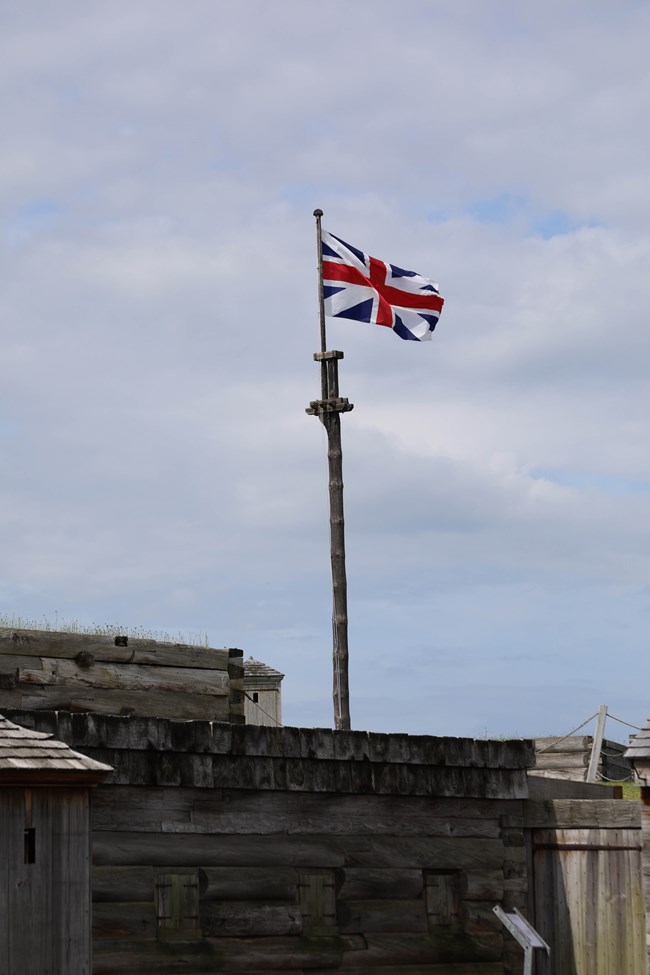Part of a series of articles titled The Oneida Carry.
Article
Fort Stanwix in the French & Indian (Seven Years) War: 1758-1760

“Mar. 26, 1759 Parole: KING GEORGE AND THE BRITISH FLAGG –
No Man to be Out of the Garrison After Twelve of the Clock that they may be Ready to Go to their Alarm Posts when the Flag is hoisted. This day the british Flagg was Hoisted for the first."
National Park Service
While no battles ever took place in and around the Oneida Carry after Fort Stanwix was built, the fort and carry served as important travel and supply bases for British expeditions against the French in 1758, 1759, and 1760.
The first expedition, in August of 1758, was the only one launched directly from the carry. When General John Stanwix arrived at the Oneida with his army, 3,600 of his 5,600 men were to be immediately detached on an expedition against the French.
The plan called for troops to use the water route on the western end of the carry (Wood Creek, Oneida Lake, Oswego River) to attack Fort Frontenac on the Canadian side of Lake Ontario (modern Kingston, Canada). The destruction of Ft. Frontenac would sever one of the supply and communication lines between Quebec and the French posts on the Ohio River and Great Lakes frontiers.
This operation was the brain child of Lieutenant Colonel John Bradstreet. Bradstreet was an English native of Nova Scotia whose military career began when his mother purchased an Ensign's command for him in 1735. His detailed knowledge of the French fortress of Louisbourg was instrumental to its capture by American colonial forces in 1745.
Bradstreet was promoted to captain in 1746 and served for a time as Lt. Governor of St. Johns, Newfoundland. He traveled to England in 1751, in search of patrons to further his military career. He returned to America in 1755 with General Edward Braddock's army. He was sent to Oswego to prepare the post for a British attack on Ft. Niagara, but the campaign was halted. Given the assignment of attacking Ft. Frontenac in 1756, Bradstreet spent the spring moving between Albany and Oswego as he tried to gather men and supplies for his attack. French capture of the posts at Oswego that summer doomed his operation to failure.
Despite these setbacks, Bradstreet showed great ability with logistics and and his speciality became overseeing the construction and coordination of water transport and supply for various British expeditions. In 1757, he was promoted to Lieutenant Colonel and made Deputy Quarter Master General of America.
Bradstreet took part in the disastrous British attack on French Ft. Carillon (Ticonderoga) in July of 1758. Immediately after this he was assigned to Gen. Stanwix's army and ordered to carry out the campaign he had attempted in 1756, the attack Ft. Frontenac.
In the end, 3,082 Regulars, Provincials, and Haudenosaunee (Six Nations) Indians, with a fleet of 123 bateaux and 95 whaleboats would carry out the attack on the fort. By August 16, the whole expedition was on its way down Wood Creek, and on the 22nd they departed Oswego and headed across Lake Ontario toward Ft. Frontenac.
Ft. Frontenac was the latest of several French fortifications that had been built on the site since 1637. Along with serving as a supply link with French posts in the west, it was also the base for French navel operations on Lake Ontario. Despite its importance, the fort stood on a very indefensible piece of land near where the St. Lawrence River left Lake Ontario. In addition, the garrison was down to 110 men (of whom only 53 were regular troops) with women and children in the fort as well.
Despite receiving early warning of Bradstreet's approach, the British force arrived on August 25th at the fort before French reinforcements could be sent from Montreal. The siege of the fort began the next day and Bradstreet's four 12 pound cannon, and four howlitzers did considerable damage. One of the shells even damaged the fort's powder magazine and fired some of the powder stored inside. Though the garrison had 30 cannon and 16 mortars, many were old and unserviceable, and only 3 men in the garrison were trained artillerymen. Design flaws in the fort's construction limited the effective use of its cannon as well.

National Park Service/M. Hutchko
Last updated: April 25, 2022
